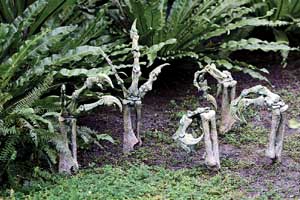Giants from Africa: Foliage of dinosaur days surrounds Sereno discoveries in conservatory
By Steve KoppesNews Office
 Above, the two dinosaur models of Afrovenator, left, and Jobaria, at right, sit among the ferns, club moss, gingkoes and other plants that once grew during the age of dinosaurs. Below, model claws of various dinosaur fossils sprout from the ground like fern fronds in the Garfield Park Conservatory exhibition, featuring Paul Sereno’s African dinosaur fossil discoveries. Other varieties that are featured in the collection are Suchomimus, Carcharodontosaurus, Sarcosuchus, Deltadromeus and Sereno’s latest find, a fish-eating reptile with a 16-foot wing span called a pterosaur. | |
 | |
Chicago paleontologist Paul Sereno has discovered some unusual-looking dinosaurs in his day, but nothing like “Daliraptor” or “Giacomettisaurus.”
The two bizarrely distorted, fanciful creatures, now on display at the Garfield Park Conservatory, were jointly inspired by two dinosaurs Sereno unearthed in South America and the surrealist artwork of Salvador Dali and Alberto Giacometti.
“It’s playing with bones that you’re used to seeing and looking at them as art,” said Chicago alumna Gabrielle Lyon, executive director of Project Exploration. There are other whimsical elements to the Garfield Park exhibition, including a dinosaur tail wrapped around a tree like a vine and a field of predatory dinosaur hands that are unfurling like fern fronds.
But Lyon and Project Exploration co-founder Sereno, Professor in Organismal Biology & Anatomy, have assembled nine more traditional-looking dinosaur skeletons in “Giants: African Dinosaurs at the Garfield Park Conservatory.”
“People are used to walking into the Field Museum or the American Museum,” Lyon said. “They’re mostly looking at a North American fauna. This is the first time that someone can actually walk into a space and get a real picture of what Africa’s dinosaurs looked like.”
The dinosaur models are displayed amid two acres of club moss, ferns, ginkgoes and other plants that have a heritage dating back to the dinosaur age. The botanical setting of the Garfield Park exhibition echoes the very first dinosaur display, which occurred in England’s Crystal Palace from 1853 to 1854. In that exhibition, sculptor Benjamin Waterhouse Hawkins collaborated with paleontologist Richard Owen to create life-sized models of the first dinosaurs ever to be discovered.
The Garfield Park Conservatory has historic roots of its own. It opened in 1908, realizing the vision of Jens Jensen, an innovative landscape architect. Avoiding the practice of other conservatories of its day, the Garfield Park Conservatory was the first to display plants in a natural-looking landscape, rather than potted and lined up on shelves.
The Chicago Park District in December 2003 completed a $4 million renovation of the conservatory’s Palm House. Now sunning itself under the Palm House’s new glass roof is Jobaria, a 70-foot-long plant-eater discovered during the first of Sereno’s six expeditions into the African Sahara. Other dinosaurs highlighted in the exhibition include Carcharodontosaurus, Africa’s answer to T. rex, and Deltadromeus, the fastest large predator that ever lived.
The exhibition also features a life-sized skeleton and a reconstruction of Sereno’s latest find, an African pterosaur. The fish-eating winged reptile sported a 16-foot wingspan. The 110-million-year-old pterosaur fossils include most of one wing and several slender teeth from its oversized jaws.
“To find a wing composed of a string of paper-thin bones in a river deposit next to the sturdy bones of dinosaurs is a remarkable feat of preservation,” Sereno said. The bones and teeth were found in Cretaceous-age rocks in Niger that ancient rivers had deposited.
Near the pterosaur site, Sereno’s team found bones of the 35-foot-long, sail-backed Suchomimus and the enormous crocodile Sarcosuchus, dubbed “SuperCroc.” Like Suchomimus and Sarcosuchus, the pterosaur dined on the abundant fish in the rivers, as evidenced by its long and slender teeth. As the jaws closed, the teeth interlocked to snare fish, leaving signs of wear on the sides.
“Somehow this huge species was able to fish on the wing. We imagine a pterosaur soaring over the water and somehow stalling to snag a fish,” Sereno said. “It was a tremendous animal.”
Project Exploration is a not-for-profit science education organization that uses the wonders of natural science to inspire city children. More information on the project is available at http://www.projectexploration.org.
The Garfield Park Conservatory, 300 N. Central Park Ave., is open daily from 9 a.m. to 5 p.m. (8 p.m. Thursdays). Suggested donation is $3. The exhibition runs through Monday, Sept. 6. For more information, see http://www.dinogiants.org.
![[Chronicle]](/images/sidebar_header_oct06.gif)